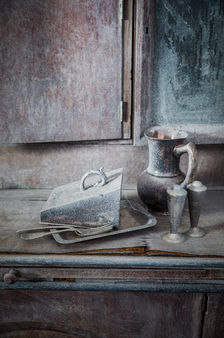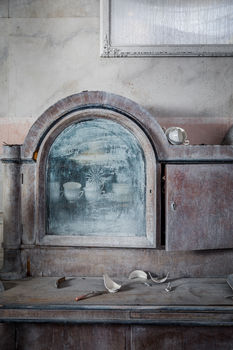
RONE IN GEELONG
Over the last two decades, Geelong-born artist Rone has built an exceptional reputation for large-scale wall paintings and immersive installations that explore concepts of beauty and decay. Rone’s site-specific installation transformed a room within Geelong Gallery in response to the architecture and history of the building, and the Gallery’s collection.
The first comprehensive survey of Rone’s career to date was presented, charting the artist’s practice from early stencil works and street art, to photographs documenting major installations that have transformed abandoned spaces.
Set dressing by interior stylist Carly Spooner. Soundtrack composed by Nick Batterham.

Feb 27- May 16, 2021
Video
The Tableau

Installation Images

The Making of Rone In Geelong
Excerpts from an essay by Tyrone Wright
The uniqueness of the building presented a lot of logistical challenges, including the limited amount of time the allocated space could be closed to the public for installation and the requirement to return the space to its existing state. The first idea was to paint the walls in the Douglass Gallery, however we couldn’t achieve this in only a few weeks. We then came up with a plan to paint the walls on panels that would then be installed over existing walls, which would give me considerably more time to create the work. Fortuitously, I was given access to a huge warehouse in Melbourne where we built a full-sized replica of the Douglass Gallery so we could hang panels, paint them and set the scene to see how it would all come together (for an exhibition that had, by then, been postponed until early 2021 due to Covid-19).
The theme of the grand reception room was inspired by a trip to Venice in late 2019, where I often found the trompe l'oeil painting within interiors more beautiful, or more dramatic, than the actual marbles and moulded plaster details. I’m not sure if the faux effects (of 2-D trompe l’oeil) show a craftsmanship that can be lost in the production of the three-dimensional forms, or whether paint better represents what it seeks to imitate, but for me, showing an illusion of what could be is sometimes more exciting than what is. My work hints at what could be or what could have been; something I try to exaggerate within each space I work.
Researching the Gallery’s collection I happened upon Florence Royce’s works. I loved the muted tones of her painted ceramics. They spoke to what I often try to represent: a fading beauty. Building on the reception room concept, I wanted each end of the room to feel different but to have continuity through the space. Light and dark was the answer to this. The sun-faded colours of the lighter end under the glass ceiling contrasting with the soot-stained darker end of the room, the residue of a burnt piano.
Many of the items of furniture are replicas; some are easy to spot, but others are simply altered originals. One example of a replica is the harp made from wood by Callum Preston. The general shape was cut from a few templates and details were added, including strings and a base. I painted the wood gold, then added a patina to age it to fit the era of the room. The harp is a non-functional replica and the piano is damaged and unplayable, but the musical soundtrack that fills the room, composed by Nick Batterham, is very real.
Behind the music
Excerpts from an essay by Nick Batterham
The soundtrack to the exhibition is a suite of three pieces of classical music featuring musicians from the Melbourne Symphony Orchestra. In response to Rone's concept of the abandoned function room with its two opposing ends being light and dark, the music features two separate ensembles that play off each other in a musical conversation of layered reflections and repetitions.
At the dark end of the room is the piano, augmented by wind and brass, while at the light end a string quartet plays. Melodies intertwine to form one larger ensemble before receding to their respective ends. The ensembles work both separately and together.
Nick Batterham is a Melbourne singer-songwriter known for performing with internationally revered bands including Blindside, The Earthmen and Cordrazine. He has also worked extensively in sound design for film and television, winning plaudits for his compositions for documentaries such as Lionel (2008), Unchartered Waters (2013) and Dying To Live (2018).
3D Scan
Off Site build images

Rone would like to acknowledge and pay his respect to the traditional Owners and Elders, past, present and emerging of the Wadawurrung People of the Kulin Nation, on whose lands this exhibition was presented.
Rone thanks the Geelong Gallery, and the many generous funding partners that have supported the delivery of the exhibition and its associated publication, programs and promotion (as detailed elsewhere in this publication).Special acknowledgement to the curator of this exhibition Senior Curator, Lisa Sullivan; Exhibitions Manager, Pip Minney; Deputy Director—Development and Commercial Operations, Penny Whitehead; Retail Manager, Jade Kellet; Building and Spaces Coordinator, John Stabb; Registrar & Collection Manager, Veronica Filmer; Elishia Furet, Learn & Audience Engagement Manager; administrative staff; volunteers; and Jason Smith, Director & CEO. It is only with the Geelong Gallery team's trust and passion that this ‘less traditional’ exhibition could be possible. Thank you.
Tyrone would also like to thank his incredible support network: exhibition team; family; friends; lenders; and collectors. Specific thanks goes to Alice Goulter for support; Sandra Powell and Andrew King for consultation; Hannah Marshall for administration; Carly Spooner of Establishment Studios for set dressing; Mo Wyse for production; Nick Batterham for music; Callum Preston for set building; Will Harvey and Lloyd Knowles for art assistance and installation; Ed Fraser and David Hooke for build assistance and installation; John McKissock for lighting; Chris Matthews of Defero Productions for filming; Tony Mott for behind the scenes photography; Peter Hatzipavlis for photographic post production and printing; Chris Dewhurst of Lite M Up
for photographic lighting; Teresa Oman for modelling; Warwick Fabrics; GH Commercial; The Rangis for additional help; and Edward Cramer and Kyle Reeve of Tope Lane for our offsite build location. All without which this exhibition would not exist. Endless gratitude to you all.






































